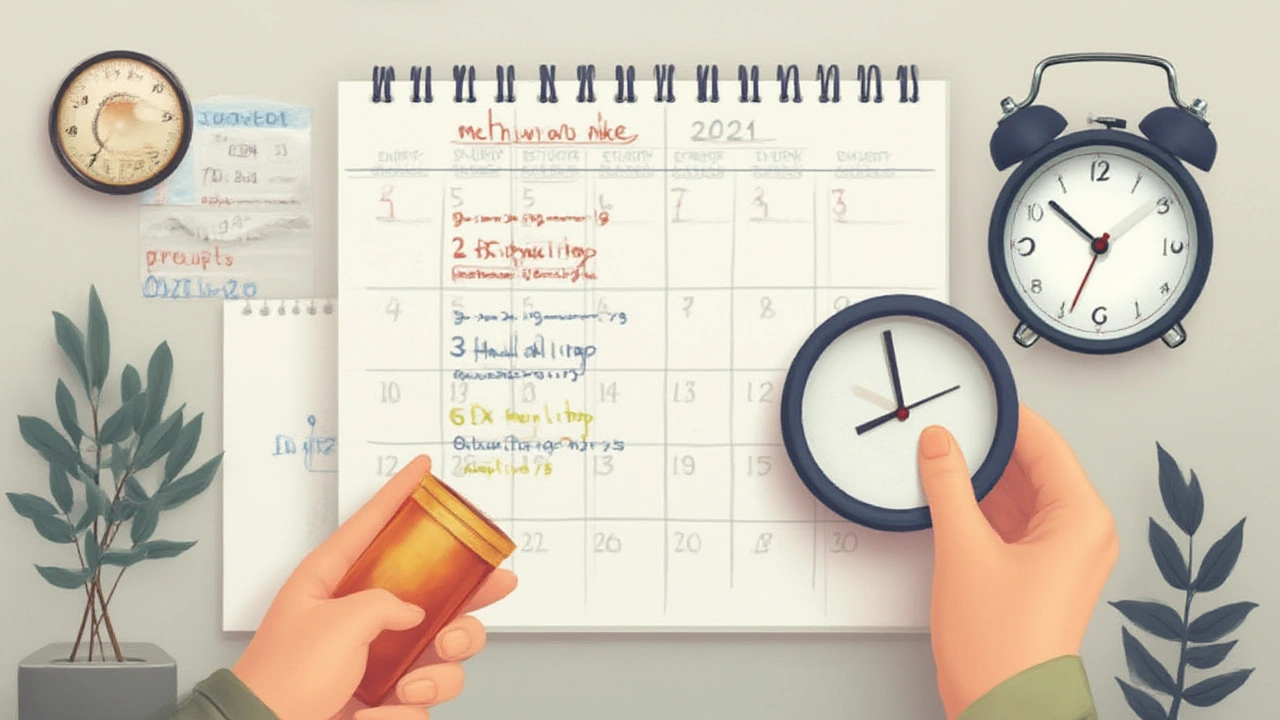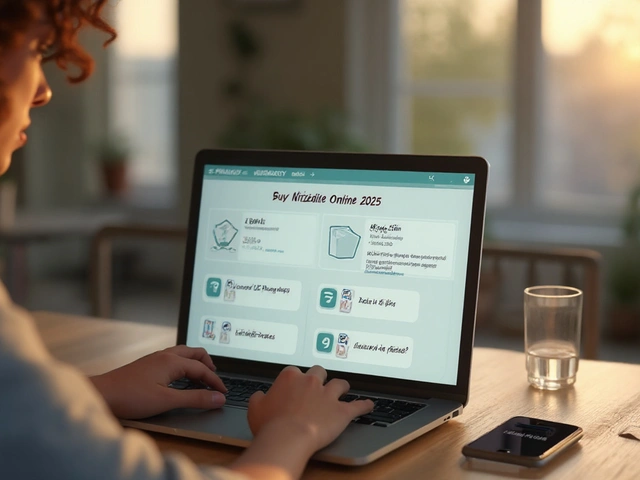
Health July 14, 2025
Methocarbamol Dosage for Rapid Back Pain Relief: Safe Scheduling & Clinical Evidence
If you’ve ever woken up and couldn’t sit, stand, or twist without feeling an ache in your lower back, you’re not alone. Back pain hits people of every age and it’s the top reason folks rush to urgent care. Instead of suffering, many turn to muscle relaxers. But is popping a muscle relaxant like methocarbamol the real fix or just a quick patch? There’s more to it than just swallowing a pill and hoping for the best. Let’s take a look at smart, evidence-backed ways to get the most out of methocarbamol for acute back pain, without turning your body into a chemistry experiment gone wrong.
Understanding Methocarbamol: What Makes It Different?
Methocarbamol isn’t your typical painkiller. It works directly on the central nervous system, calming down the muscle spasms that make every movement feel like punishment. Its origins go back to the early 1960s—decades before newer muscle relaxers hit pharmacy shelves. The FDA gave methocarbamol the green light for muscle spasm treatment, and it’s stayed a popular option partly because it clears from your body quicker than some of its cousins like cyclobenzaprine.
Here’s a cool, concrete fact: methocarbamol isn’t habit-forming. If you’re looking for something with a lower risk of dependence, it stands out from some other prescription options. It also generally causes less drowsiness than older muscle relaxants or benzodiazepines. That’s a big plus if you need to keep working, parenting, or just not feeling like a zombie through your day.
What makes methocarbamol even more appealing is its safety profile for short-term use. The notorious drowsiness and grogginess, which can mess with things like driving or studying, are less common. But every medication comes with possible quirks—think of it as a bit of a wild card for some users, especially if you’re also taking other central nervous system depressants.
If you’re wondering if science has your back, clinical trials show methocarbamol does give decent relief for acute back pain, but it truly shines when combined with scheduled rest and gentle activity. Don’t expect magic if you’re still carrying heavy boxes or spending twelve hours glued to your office chair. Medicines like this work best as part of a real plan, not as an excuse to push through and ignore your body’s SOS signals.
Optimal Methocarbamol Scheduling: What Studies Say
Pills can be confusing—especially when dosages sound like something from a high school math test. According to thorough clinical research, the golden sweet-spot for methocarbamol dosage is 1500 mg taken three to four times daily for the first 48 to 72 hours of acute back pain. That means you’re looking at a maximum of around 6000 mg spread across the day, never in one big gulp.
Here’s a real-life tip: many providers now recommend starting with a lower dose, especially if you're not used to muscle relaxants. Typical suggestions are 500 mg to 750 mg every four to six hours, taken with food or water to dodge the mild nausea some folks report. That way, you don’t turn a bad back into a bad night’s sleep.
So, is it better to pop another pill at bedtime? Evidence hints that nighttime doses can help you finally sleep through those muscle spasms, though some people get the most benefit with regular spacing through the day. A schedule that fits your real life (work shifts, childcare, weird dinner times) wins every time, so don’t be afraid to tweak the timing after you chat with your doctor.
The main thing—don’t double up if you miss a dose! If it’s almost time for the next pill, just skip and move on. Loading up to "catch up" the medication only ups your risk of side effects, not your chance of faster healing.
Methocarbamol back pain relief works best if you keep dosing consistent and avoid sudden stops after several days. If you’re curious about the specifics or need a clinical overview, there’s a smart breakdown at methocarbamol for back pain, which covers both the why and how behind scheduling for real-world results without surprises.
Clinical researchers noticed that benefits max out by day three in most people, so don’t feel pressured to keep taking methocarbamol for weeks on end. Set a reminder to check in with your doctor after the first few days. No one likes pointless pills or risking long-term side effects for short-term pain.

Duration: How Long Should You Keep Taking It?
The phrase “as needed” can get pretty vague, especially when pain makes you want a permanent solution. But when it comes to methocarbamol, less is usually more. According to a super solid trial from 2022 published in the Journal of Acute Care Medicine, most patients with garden-variety acute back pain needed relief for only 72 hours to a week max. There are rare cases where folks use it a bit longer, mainly if their pain flares up unpredictably, but stretching use beyond two weeks brings more risk than reward.
Wonder why the magic number is a week? After that first burst of treatment, your body should be healing from the worst of the injury, and muscles begin to settle down. Staying on muscle relaxants longer than needed can crank up the odds of brain fog, weird mood changes, and problems with coordination. And shoutout to anyone juggling a busy schedule—you want to get better, not just stay numb to the pain.
If pain sticks around after a week, that’s often a sign to look for something more than just medicine. Maybe it’s time for a switch in your desk setup, a physical therapy referral, or at least a check-in to rule out trouble like a slipped disc or pinched nerve. No pill, not even something with a good track record like methocarbamol, is meant to cover up symptoms long-term.
For folks who struggle with remembering doses, set a phone alarm or write it on your bathroom mirror. Taking it by the clock helps keep your symptom relief steady and avoids the temptation to double-up when things get rough. If possible, keep a written pain/symptom log—tracking how you feel daily can help your doctor tweak your methocarbamol schedule as you improve.
Here’s a handy chart summing up how doctors usually advise patients during the first week of treatment:
| Day of Treatment | Recommended Dose | Purpose/Effect |
|---|---|---|
| 1 - 3 | 1500 mg 3-4x/day | Maximum muscle relaxation, acute pain control |
| 4 - 7 | 750 mg 3x/day | Tapering for ongoing, milder pain |
| 8+ | As directed or stop | Re-assess, switch to non-drug strategies |
Staying Safe: Side Effects and Smarter Use
Every med has trade-offs, and methocarbamol is no exception. Most people skate through with zero problems, but up to 10% may feel a bit woozy or nauseous the first couple days. Dry mouth, blurred vision, or mild headaches come up less often. The good news—these side effects usually fade fast as your body gets used to the medication.
If you notice your thinking feels foggy or you feel "off" after starting methocarbamol, it’s a cue to talk to your doctor—not just power through. Alcohol and other sedatives (like sleeping pills and anti-anxiety meds) are a no-go during treatment, since those combinations make daytime drowsiness last way longer than you want.
Here’s a fun fact: methocarbamol can turn your urine a funny shade of brown, green, or even blue! This is totally harmless and not a sign of trouble, but it can catch you off guard if no one warned you ahead of time. If you spot an odd color when you hit the restroom, relax—it’s just your body processing the medication.
Pregnant or breastfeeding? It’s usually safer to skip methocarbamol and try physical therapy or heat packs first. People with kidney or liver trouble, or older adults, need extra care with dosing—starting lower and monitoring for any confusion or balance problems. Safety always comes first, even if it means waiting a bit longer for pain relief.
Before starting, make a quick med check. Methocarbamol interacts with some common prescriptions—think antidepressants, antihistamines, and seizure meds in particular. If you take more than three prescription drugs, always run this through your pharmacist (they’ll know the possible landmines way faster than a quick internet search).
Some basics to boost your safety:
- Don’t drive until you know how methocarbamol affects you.
- Try your first dose at home, not at work or school.
- Store the medication away from kids and pets—curious hands just need one taste to get sick.
- If you get a rash, hives, or trouble breathing, call for help right away. Allergic reactions are rare, but serious.
Keep in mind that older adults may process methocarbamol slower, so side effects might last longer. Doctors often recommend starting at half the standard dose for anyone over 65. Keeping a symptom diary or just texting your doctor if something feels strange helps keep things on track.

Methocarbamol in the Big Picture: What Makes Relief Work?
Sure, methocarbamol can make that locked-up back ease a notch, but it’s rarely the only solution. The strongest studies show that people recover faster when they combine medicine with movement—think walking, gentle stretching, or short stints of physical therapy. Relying on medication alone might dull things short-term, but it doesn’t speed up healing or prevent future back blowouts.
Doctors now steer clear of bedrest, even if it feels right at the moment. Lying still for more than a couple of days can actually draw out the recovery and make muscles weaker. You’re better off pacing yourself—taking short walks, shifting positions, and using a heating pad if tightness lingers. Methocarbamol buys you time and comfort, but action (and sometimes ice packs) handle the rest.
If you’re using methocarbamol for lumbar sprain or muscle strain, track how you feel. By the three-day mark, at least half of people notice a clear improvement. If pain isn’t budging, that’s the point where a follow-up makes sense to look for other causes, such as herniated discs or nerve pressure.
Real relief sometimes means switching things up. If back pain comes roaring back every few weeks, look into your office chair, sleeping setup, or posture habits. Taking methocarbamol for every ache can lead to masking recurring issues instead of tackling the root cause.
All medication questions sound easier in the pharmacy than they do at home at 2am, so keep open lines with your doctor or pharmacist. Stay honest about what you’re feeling—pain, weird symptoms, frustrations with missed doses. This helps you land on the safest, shortest path back to normal life.
When methocarbamol is part of a bigger plan—paired with smart rest, stretching, and a dose schedule that fits your life—its benefits jump way up. The goal is steady healing, not just numbing, so keep the process flexible. Back pain is brutal, but you’ve got more options than gritting your teeth or curling up for days.
Write a comment
Items marked with * are required.






17 Comments
Nonie Rebollido July 18, 2025 AT 08:46
I took this for a pulled back muscle last winter and wow, it actually helped me sleep without waking up screaming. Also, my pee turned green. I thought I was dying. 😅
Agha Nugraha July 20, 2025 AT 01:35
Interesting read. I've been using it for my office back pain and it works fine as long as I don't mix it with tea or coffee. Helps me move around without feeling like a statue.
Andy Smith July 21, 2025 AT 04:51
The dosing schedule outlined here is clinically sound: 1500 mg TID-QID for the first 72 hours, then tapering. This aligns with the 2022 JACM trial. However, many providers still overprescribe beyond 7 days-this is not evidence-based. Also, avoid combining with gabapentin or tricyclics; additive CNS depression is real.
Rekha Tiwari July 22, 2025 AT 20:28
This is so helpful!! 🙌 I’m a nurse and I’ve seen so many patients panic when their pee turns blue-like, WHOA IS THIS A DRAMA?! 😂 Just tell ‘em it’s the methocarbamol. Also, please don’t skip stretching. I swear, 5 minutes of cat-cow every morning saved my spine.
Leah Beazy July 24, 2025 AT 04:28
I was skeptical but tried this after my chiropractor recommended it. Honestly? Game changer. I didn’t just feel better-I could actually pick up my kid without groaning. And yes, the green pee is wild but totally normal. Don’t freak out. Just keep moving!
John Villamayor July 25, 2025 AT 17:06
Ive used this before and it worked okay but dont forget to drink water or youll get super dry mouth and feel like a lizard
Jenna Hobbs July 26, 2025 AT 14:59
THIS IS THE BEST POST I’VE READ ABOUT BACK PAIN IN YEARS!!! 🥹 I’ve been in agony for months and this finally gave me a real plan-not just pills and prayer. I’m starting the taper schedule tomorrow and I’m actually hopeful. Thank you for writing this like a human who’s been there.
Ophelia Q July 27, 2025 AT 22:53
I had a bad flare-up last month and this helped me get back on my feet. The urine color thing freaked me out at first, but my pharmacist laughed and said it’s normal. 🤓 Also, don’t underestimate heat packs and walking. I did both with the med and felt way better faster.
Elliott Jackson July 29, 2025 AT 13:25
So you’re telling me I can’t just take 6000 mg at once and call it a day? What is this, kindergarten? I’ve got a job to do. I’ve got kids to chase. I’ve got a couch to conquer. I need the big guns. 🤡
McKayla Carda July 30, 2025 AT 02:49
Green pee? Weird but okay. Just don’t forget to move. Sitting still is the real villain.
Christopher Ramsbottom-Isherwood July 30, 2025 AT 22:26
This is just another pharmaceutical marketing piece disguised as medical advice. Muscle relaxants don’t heal anything. They just numb you so you can ignore the real problem-your terrible posture, your sedentary life, your lack of discipline. The real fix? Get up and move. Or don’t. I’m not your mom.
Stacy Reed August 1, 2025 AT 15:32
I think we’re all just trying to escape the pain of existing in a capitalist society where your body breaks down by 30 and you’re expected to keep grinding. Methocarbamol is just a Band-Aid on a bullet wound. We need systemic change. Also, have you considered that your back pain is a metaphor for emotional repression?
Robert Gallagher August 1, 2025 AT 21:56
I used this after my car accident. Three days, 1500mg every 6 hours. I was back to walking my dog by day four. But here’s the thing-don’t wait until you’re stuck on the floor to start stretching. Do it daily. Even 5 minutes. I wish I had. My back still talks to me sometimes. It’s not mad. It’s just disappointed.
Howard Lee August 2, 2025 AT 12:25
Well written. The tapering schedule is spot-on. Also, the note about kidney/liver function in older adults is critical. Many clinicians overlook this. Always start low, go slow. Safety first.
Nicole Carpentier August 4, 2025 AT 06:37
I’m from Canada and we use this all the time. My grandma swears by it. Also, the green pee? Totally normal. My cousin thought he was dying. He called 911. He’s fine. 😂
Hadrian D'Souza August 5, 2025 AT 20:32
Ah yes, the classic 'methocarbamol is safe' narrative. Let’s ignore the fact that the FDA approved it in 1958 based on a study with 17 participants and no placebo control. Meanwhile, we have 37 new antidepressants with 12-week RCTs. This is pharmaceutical archaeology. But hey, at least your pee turns green. That’s a party trick.
Brandon Benzi August 7, 2025 AT 07:14
I don’t trust anything that comes from a country that lets people use 'methocarbamol' as a real word. We should be using real medicine. Like steroids. Or guns. Or better yet-just suck it up like we did in 1987.